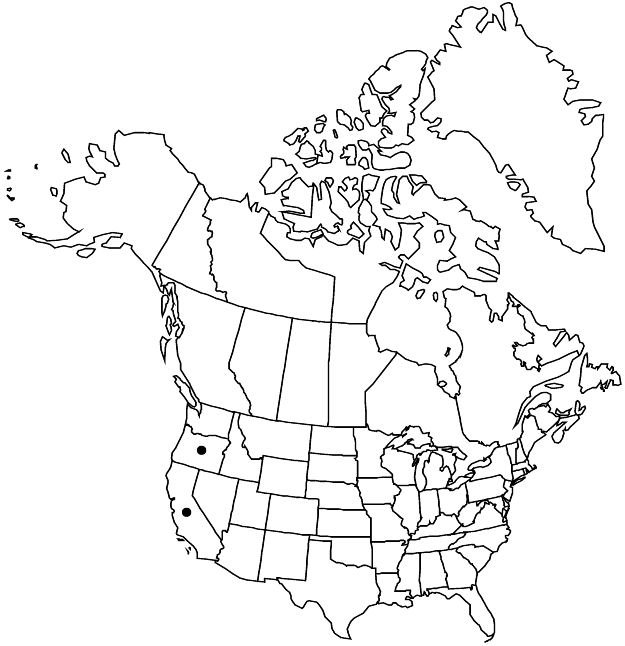Sidalcea hickmanii
Pittonia 1: 139. 1887.
Herbs, perennial, 0.1–0.8 m, not glaucous, with thick, woody taproot or caudex, without rhizomes. Stems several to many (ca. 3–20+), clustered, erect to ascending, branched or unbranched, solid, usually densely stellate-canescent. Leaves cauline, evenly arrayed on stem, usually similar in size, shape; stipules linearlanceolate to ovate, 2–9 × 1–3 mm, widest above base, width sometimes exceeding stem diam.; petiole 0.6–3 (–9) cm, 1/2–3 times as long as blade, apex often with pulvinus; blade orbiculate or reniform to flabelliform, unlobed and margins coarsely crenate to shallowly or deeply lobed, 1–7 × 1–7 cm, usually wider than long, base truncate or cordate, apex rounded, surfaces stellate-hairy. Inflorescences erect, infrequently ascending, usually spiciform, dense or open, calyces overlapping or not, branched or unbranched, 2–20+-flowered, proximal flowers scattered, usually more congested distally, not notably elongate in flower, not 1-sided, (1.5–) 3–25 cm, usually longer in fruit; bracts linear to ovatelanceolate or oblong, undivided, 2-fid, or divided, 2–8 (–12) mm, not involucrelike, distal entire to 2-fid, stipulelike, proximalmost not involucrelike, divided to base, much shorter than to nearly equaling calyx. Pedicels 1–4 (–5) mm; involucellar bractlets (2 or) 3, 2–10 mm, shorter to slightly longer than calyx. Flowers usually bisexual, infrequently unisexual and pistillate; calyx 4–12 mm, densely to sparsely stellate-puberulent to long-bristly; petals usually pale-pink to pink-lavender, rarely white, veins not conspicuously whitened, 5–17 mm; staminal column 4–7 mm, hairy; anthers white to pale pinkish or pale-yellow; stigmas (4–) 6 or 7 (–10). Schizocarps 4–7 mm diam.; mericarps usually (4–) 6 or 7 (–10), (1.5–) 2–2.5 mm, glabrous, sides usually smooth, thin, margins and back usually lightly reticulate-veined, transversely corrugated, back usually with medial, raised line, not pitted, mucro absent. Seeds 1–2 mm.
Distribution

Calif., Oreg.
Discussion
Sidalcea hickmanii is found in isolated populations from southern California to southwestern Oregon and appears to have a relict distribution. K. Andreasen and B. G. Baldwin (2001, 2003) suggested that it is basal within Sidalcea. It is distinctive in having three (normally two in subsp. petraea) involucellar bractlets attached to the calyx, no mucro on the mericarps, and leaves that are almost the same size and shape throughout the stem. Each subspecies apparently represents a distinct relictual colony; the sexuality of these is not well known because of the paucity of specimens. As in many sidalceas, this species in particular appears to be fire-dependent.
Subspecies 7 (7 in the flora).
Selected References
None.
Lower Taxa
Key
| 1 | Leaf blades usually lobed, incised ± to base; California | > 2 |
| 1 | Leaf blades unlobed, incised to 1/2 length; California, Oregon | > 3 |
| 2 | Bracts (7–)10–12 mm, equaling or shorter than calyx; c San Luis Obispo County. | Sidalcea hickmanii subsp. anomala |
| 2 | Bracts 5.5–7 mm, shorter than calyx; Napa County. | Sidalcea hickmanii subsp. napensis |
| 3 | Involucellar bractlets 2(–3); petals white to pale pink; flowers bisexual or pistillate; sw Oregon. | Sidalcea hickmanii subsp. petraea |
| 3 | Involucellar bractlets 3; petals pink, pale pink, pinkish lavender, or pale lavender; flowers bisexual; California | > 4 |
| 4 | Bracts broadly lanceolate, 5–7(–10) × 2.5–4 mm, slightly shorter than calyx; involucellar bractlets equaling or slightly shorter than calyx; leaf blades: distal unlobed or incised to 1/4 length; Santa Barbara and San Bernardino counties. | Sidalcea hickmanii subsp. parishii |
| 5 | Plants 0.4–0.8 m; stems brick red, greenish, or grayish; calyces stellate-puberulent, hairs longest at margins; involucellar bractlets 2–7 mm; largest leaf blades deeply cordate, 2.5–7 cm wide; inflorescences dense; Monterey County. | Sidalcea hickmanii subsp. hickmanii |
| 6 | Bracts of distal flowers 1, cupped; leaf blades 0.6–1.5 × 0.7–2.2 cm; stems distally stellate-hairy, hairs appressed, 0.2–0.5 mm; plants 0.1–0.4 m; inflorescences not spiciform, to 10-flowered; calyces 4–5.5 mm; n Lake County. | Sidalcea hickmanii subsp. pillsburiensis |
| 6 | Bracts of distal flowers usually 2, flat or cupped; leaf blades (1–)2–4 × (1–)2.7 cm; stems distally hairy, hairs tufted, 0.5–1.2 mm; plants (0.2–)0.3(–0.4) m; inflorescences spiciform in age, 10+-flowered; calyces 6–7 mm; Marin County. | Sidalcea hickmanii subsp. viridis |
"/2-3timesaslongasblade" is not declared as a valid unit of measurement for this property."elongated" is not a number."diam" is not a number.